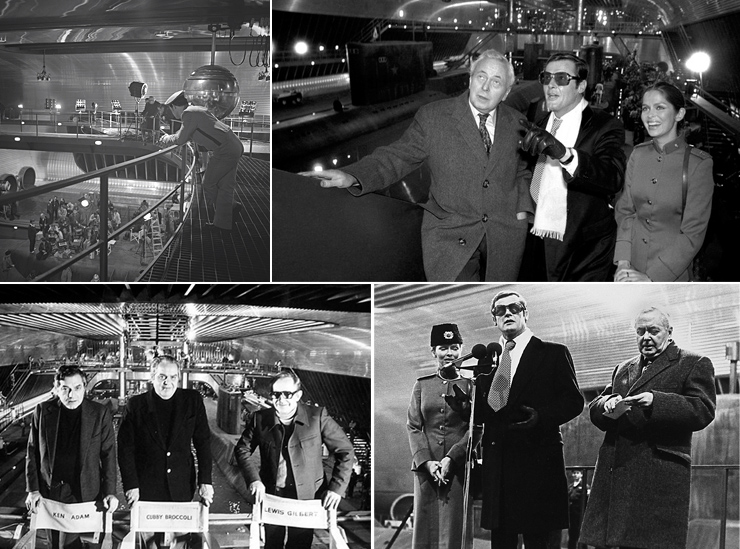The Spy
|
||
|
||
The Spy
|
||
|
||
|
|
|||
|
Filming began at Pinewood Studios on 31 August 1976 on Gogol's Kremlin office set designed by Ken Adam. Walter Gotell who had appeared as Morzeny in From Russia With Love in 1963, made his first appearance as the Russian General, a role he would reprise in the next five Bond films. |
|||
|
|
|||
|
Shooting continued on other sets designed by Ken Adam, including the interior of Stromberg's Atlantis headquarters; the shots inside the two kidnapped nuclear submarines; and Mojave Club, M's Egyptian office and Q's laboratory set. Work then began inside the vast ‘007 Stage’ where the climax of the film was shot in late 1976. Ken Adam and director of photography Claude Renoir (grandson of impressionist painter Pierre-Auguste Renoir) had huge problems in lighting the action inside the super-tanker set. Renoir admitted that he was also hampered by failing eyesight. Production Designer Adam called upon his friend the noted director Stanley Kubrick, who suggested building floodlighting into the 334ft stage as part of the set itself, so that when switched on most of the interior could be illuminated. Kubrick's daughter Katharina worked on The Spy Who Loved Me and is credited as the designer of the metal teeth worn by Richard Kiel who played Jaws. |
|||
 |
|||
|
The ‘007 Stage’ was formally christened by recently resigned British Prime Minister Harold Wilson on 5 December 1976, in a ceremony attended by stars and crew. Principal photography finished at Pinewood on 26 January 1977 and post-production began to bring the whole film together. The entire production process was recorded by the BBC for the Open University in an eight-part documentary entitled ‘Mass communication and society’, which first aired on BBC2 in the early hours of the morning of 17 July 1977, and was shown at irregular intervals until 16 October 1977. The series was repeated in 1983 and has never been commercially available apart from the inclusion of one episode as an extra on the original US DVD release of The Spy Who Loved Me in 1998. |
|||
|
|||
|
On 20 May 1977, stars Roger Moore and Barbara Bach attend the Cannes Film Festival to promote the upcoming release of The Spy Who Loved Me. The pair then attended the Royal World Charity Premiere of the film at the ODEON Leicester Square on the evening of July 7, 1977. The film opened in the USA on 13 July in New York and later went on general release from early August. Despite being up against Star Wars at the US box-office, the tenth James Bond film was a huge hit in the United States. The Spy Who Loved Me was the top money-maker at the UK box-office in the summer of 1977 - its nearest rival Star Wars would not open in the UK until December of that year. The Spy Who Loved Me remained at the ODEON Leicester Square until September 15, 1977, and later played simultaneously at the London Pavilion and Dominion, Tottenham Court Road until the end of the year, finishing its Pavilion engagement on February 22, 1978. A year later it was successfully re-released with Live And Let Die and in 1980 paired with The Pink Panther Strikes Again. In November 1980 the film returned to the London Pavilion as part of a James Bond Festival, and played on a double-bill with From Russia With Love. A final re-release on a double-bill with Moonraker in April of 1981 ended its theatrical life. The Spy Who Loved Me then premiered on UK television on the ITV network on March 28, 1982, when it was seen by a staggering 22.9 million viewers. On Sunday April 20, 2008 The Spy Who Loved Me returned to London's West End when it played in a special digital version brought back to the big screen by Park Circus at the Empire Leicester Square - a 100 yards from where it had premiered 31 years earlier. |
|||
 |
|||
|
The release of The Spy Who Loved Me in July of 1977 was the longest gap between new Bond films since the series began in 1962, although if you lived in London the wait was tempered by a season of Sean Connery's James Bond films at the London Pavilion in May/June 1975, followed by a re-release of The Man With The Golden Gun/Live And Let Die Service in November. The first four films of the series had also premiered on UK television between October 1975 and February 1977. ‘Cubby’ Broccoli's big gamble paid off, and The Spy Who Loved Me lived up to at least two of its tag-lines: (depending on your personal opinion!) It's the BIGGEST. It's the BEST. It's BOND And BEYOND! The huge worldwide success of The Spy Who Loved Me paved the way for the excesses that followed in the next decade, with the Bond series going from strength-to-strength commercially, if not aesthetically. The series still bears the name of the man who single-handedly rescued the franchise from almost disaster with the departure of his producing partner in 1975. The iconic stature of the tenth James Bond film, and star Roger Moore's favourite from his tenure, is the only title from his seven outings that can truly hold that accolade. From its jaw-dropping pre-title sequence; through the marvellous main titles by Maurice Binder (with Marvin Hamlisch and Carly Simon's ‘Nobody Does It Better’ torch-song); Richard Kiel's larger-than-life henchman, Ken Adam's Oscar nominated production design; Derek Meddings’ realistic miniatures, and the iconic Lotus Esprit, The Spy Who Loved Me reaches middle-age with a wry smile and a tongue-in-cheek twinkle that only its late lamented star could pull off. R.I.P Sir Roger Moore and a happy 40th to The Spy Who Loved Me! |
|||
 |
|||
|
|